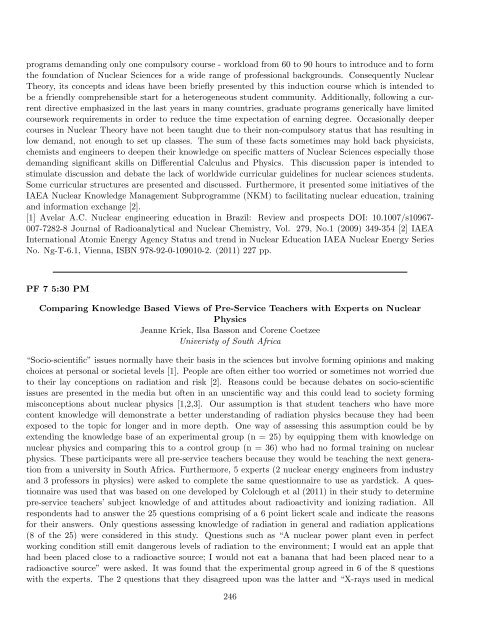Program - Brookhaven National Laboratory
Program - Brookhaven National Laboratory
Program - Brookhaven National Laboratory
Create successful ePaper yourself
Turn your PDF publications into a flip-book with our unique Google optimized e-Paper software.
programs demanding only one compulsory course - workload from 60 to 90 hours to introduce and to form<br />
the foundation of Nuclear Sciences for a wide range of professional backgrounds. Consequently Nuclear<br />
Theory, its concepts and ideas have been briefly presented by this induction course which is intended to<br />
be a friendly comprehensible start for a heterogeneous student community. Additionally, following a current<br />
directive emphasized in the last years in many countries, graduate programs generically have limited<br />
coursework requirements in order to reduce the time expectation of earning degree. Occasionally deeper<br />
courses in Nuclear Theory have not been taught due to their non-compulsory status that has resulting in<br />
low demand, not enough to set up classes. The sum of these facts sometimes may hold back physicists,<br />
chemists and engineers to deepen their knowledge on specific matters of Nuclear Sciences especially those<br />
demanding significant skills on Differential Calculus and Physics. This discussion paper is intended to<br />
stimulate discussion and debate the lack of worldwide curricular guidelines for nuclear sciences students.<br />
Some curricular structures are presented and discussed. Furthermore, it presented some initiatives of the<br />
IAEA Nuclear Knowledge Management Subprogramme (NKM) to facilitating nuclear education, training<br />
and information exchange [2].<br />
[1] Avelar A.C. Nuclear engineering education in Brazil: Review and prospects DOI: 10.1007/s10967-<br />
007-7282-8 Journal of Radioanalytical and Nuclear Chemistry, Vol. 279, No.1 (2009) 349-354 [2] IAEA<br />
International Atomic Energy Agency Status and trend in Nuclear Education IAEA Nuclear Energy Series<br />
No. Ng-T-6.1, Vienna, ISBN 978-92-0-109010-2. (2011) 227 pp.<br />
PF 7 5:30 PM<br />
Comparing Knowledge Based Views of Pre-Service Teachers with Experts on Nuclear<br />
Physics<br />
Jeanne Kriek, Ilsa Basson and Corene Coetzee<br />
Univeristy of South Africa<br />
“Socio-scientific” issues normally have their basis in the sciences but involve forming opinions and making<br />
choices at personal or societal levels [1]. People are often either too worried or sometimes not worried due<br />
to their lay conceptions on radiation and risk [2]. Reasons could be because debates on socio-scientific<br />
issues are presented in the media but often in an unscientific way and this could lead to society forming<br />
misconceptions about nuclear physics [1,2,3]. Our assumption is that student teachers who have more<br />
content knowledge will demonstrate a better understanding of radiation physics because they had been<br />
exposed to the topic for longer and in more depth. One way of assessing this assumption could be by<br />
extending the knowledge base of an experimental group (n = 25) by equipping them with knowledge on<br />
nuclear physics and comparing this to a control group (n = 36) who had no formal training on nuclear<br />
physics. These participants were all pre-service teachers because they would be teaching the next generation<br />
from a university in South Africa. Furthermore, 5 experts (2 nuclear energy engineers from industry<br />
and 3 professors in physics) were asked to complete the same questionnaire to use as yardstick. A questionnaire<br />
was used that was based on one developed by Colclough et al (2011) in their study to determine<br />
pre-service teachers’ subject knowledge of and attitudes about radioactivity and ionizing radiation. All<br />
respondents had to answer the 25 questions comprising of a 6 point lickert scale and indicate the reasons<br />
for their answers. Only questions assessing knowledge of radiation in general and radiation applications<br />
(8 of the 25) were considered in this study. Questions such as “A nuclear power plant even in perfect<br />
working condition still emit dangerous levels of radiation to the environment; I would eat an apple that<br />
had been placed close to a radioactive source; I would not eat a banana that had been placed near to a<br />
radioactive source” were asked. It was found that the experimental group agreed in 6 of the 8 questions<br />
with the experts. The 2 questions that they disagreed upon was the latter and “X-rays used in medical<br />
246
















